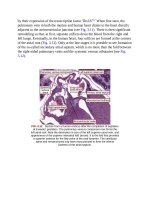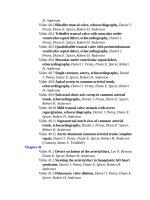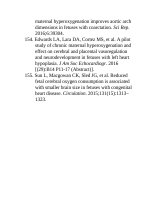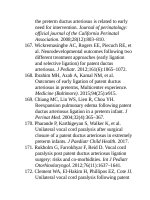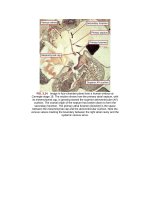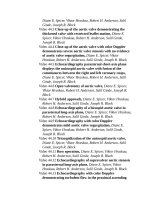Andersons pediatric cardiology 1176
Bạn đang xem bản rút gọn của tài liệu. Xem và tải ngay bản đầy đủ của tài liệu tại đây (106.29 KB, 3 trang )
thatisalsobisinuate.20
ValvarAorticStenosis
Introduction
Valvaraorticstenosisisthemostcommontypeofleftventricularoutflowtract
obstruction.Inthepediatricpopulation,acongenitallymalformedaorticvalve
(i.e.,bicuspidorbifoliateaorticvalve)isbyfarthemostcommoncauseofaortic
stenosis.Rheumaticaorticstenosisduetofusionofthecommissureswith
scarringandprogressivecalcificationofthecuspsisalesscommoncauseinthe
high-incomenations.Calcificdegenerationofatricuspidaorticvalveisa
commonetiologyforaorticstenosisintheolderadultpopulation.
GeneticsandEpidemiology
Abicuspidaorticvalvehasanestimatedprevalenceinthegeneralpopulationof
between0.5%and2%,makingitthemostcommoncongenitalheart
defect.2,21,22Thereisamalepredominanceofapproximately2:1to3:1.23
Bicuspidaorticvalveisoftenassociatedwithothercongenitalheartdefects,
mostcommonlywithventricularseptaldefectandotherleft-sidedobstructive
lesions,includinginterruptedaorticarch,coarctationoftheaorta,24hypoplastic
leftheartsyndrome,25andShonesyndromewithconcomitantsubvalvaraortic
stenosisandmitralvalvestenosis.26Approximately50%to75%ofpatientswith
coarctationwillhaveabicuspidaorticvalve(Box44.1).24
Box44.1
CongenitalHeartDefectsAssociatedWith
BicuspidAorticValve
Ventricularseptaldefect
Coarctationoftheaorta
Interruptedaorticarch
Hypoplasticleftheartsyndrome
Subaorticstenosis
Mitralvalvestenosis
Thegeneticdeterminantsofbicuspidaorticvalvearestillnotwelldefined.
Certaingeneticsyndromeshaveaclearassociationwithbicuspidaorticvalve.
Mostnotably,womenwithTurnersyndrome,duetoacompleteorpartiallossof
asecondXchromosome,haveaprevalenceofbicuspidaorticvalveofgreater
than20%to30%.27,28Bicuspidaorticvalveisalsomorecommoninfamilial
aortopathysyndromesincludingLoeys-Dietzsyndrome,associatedwith
pathogenicvariantsintheTGFBR1andTGFBR2genes,andcertainformsof
familialthoracicaorticaneurysmanddissectionsyndrome.29
Thegeneticsofnonsyndromicformsofbicuspidaorticvalveappearstobe
morecomplex.Familialclusteringiswellrecognizedandsuggestiveofa
mendelianpatternofinheritance.30Studiesreportanincidenceofbicuspidaortic
valveorotherleft-sidedobstructivecongenitalheartdefectsin5%to24%of
first-degreerelativesofpatientswithbicuspidaorticvalve.30,31Inaprospective
studyofasymptomaticfamilymembersofpatientswithbicuspidaorticvalve
whounderwentscreeningechocardiograms,36.7%ofthefamilieshadatleast
oneadditionalfamilymemberwithbicuspidaorticvalve.32
VariantsinthesignalingandtranscriptionalregulatorgeneNOTCH1have
beenimplicatedinsomefamilialcasesofbicuspidaorticvalve.33,34TheACTA2
gene,whichencodesforsmoothmuscleα-actin,hasalsobeenimplicatedin
familieswithbicuspidaorticvalve,alongwithapredispositionforaortic
aneurysmsanddissections.35However,inthemajorityofcasesofbicuspid
aorticvalve,nosingle-genemodelclearlyexplainstheinheritance,suggesting
thereareimportantmultigenetic,epigenetic,andenvironmentalmodifiersthat
areresponsibleforthevariablepenetranceandphenotypicexpression.36,37
Progressivedilationofthethoracicaortaisawell-describedcomplicationin
bothsyndromicandnonsyndromicformsofbicuspidaorticvalvedisease.Both
theaorticsinusesofValsalvaandproximalascendingaortaabovethe
sinotubularjunctionarelargercomparedwithpatientswithnormaltrileaflet
aorticvalves.Mechanicalfactorsrelatedtotheabnormalpostvalvarturbulence
inthesettingofaorticstenosishavebeenimplicatedinthepathogenesisofaortic
dilation,calledpoststenoticdilation.38However,progressiveaorticdilationhas
beendocumentedeveninpatientswithfunctionallynormalbicuspidaortic
valves,suggestingthereisageneticbasisthatresultsinanintrinsicstructural
developmentalabnormalityoftheaorticwall.39,40Histologically,theaortopathy
